Abstract
A highly regioselective Wacker oxidation has been developed for the oxidation of cinnamyl azides. The catalytic oxidation tolerates the azide functionality, and more than 15 β-azido ketones were isolated (25−92% yield). High regioselectivity for the aryl ketone is observed in all cases. A robustness screen was conducted to determine functional group tolerance. The products of the oxidaiton can be readily diversified.
Graphical abstract

Azides are an attractive functional group due to their versatile reactivity, which provides a distinct handle for further functionalization.1 Our laboratory has been interested in exploiting the unique rearrangement of allylic azides.2,3 We are therefore interested in identifying catalyzed protocols that are compatible with an allylic azide. It would be exciting to demonstrate the compatibility of allylic azides with ubiquitous palladium catalysis. The Wacker oxidation, as a classic palladium-catalyzed alkene functionalization, seemed a logical choice for exploration. No Wacker oxidations of allylic azides have been reported. It was not initially clear that an allylic azide would be compatible with oxidative conditions.4,5 The azide could react with the metal center directly and inhibit the reaction or poison the catalyst. Allylic azides are known to rearrange, which could further complicate the Wacker oxidation.2,6,7 However, such a reaction could provide efficient catalytic access to β-azido-ketones.
The β-azido-ketone motif has been used as a heterocycle precursor, an intermediate for total syntheses, and a pharmaceutical building block (Scheme 1).8−13 Additionally, the β-azido-ketone has been used as a triplet nitrene source.14−16 Typically, this motif is synthesized by conjugate addition of an azide anion or by displacement of sensitive β-halo-ketones.12,17,18
Scheme 1.
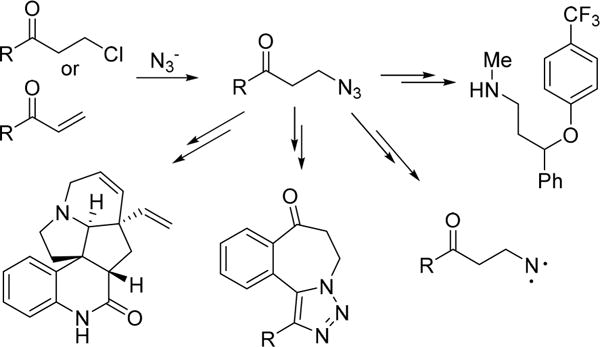
β-Azido-Ketone Syntheses and Applications
The Wacker oxidation has been widely utilized both industrially and academically.19 Terminal alkenes are excellent substrates, and classically, the ketone product is obtained. However, chemists have struggled to deliver Wacker oxidation methods that provide high selectivity for the oxidation of internal alkenes. This is best illustrated by examining the oxidation of β-methylstyrene (Scheme 2i). While styrene oxidation affords acetophenone with near perfect selectivity,20−22 the oxidation of β-methylstyrene is only modestly selective for phenylacetone.23,24 Recent progress has enabled the regioselective oxidation of some internal alkenes. Most notable are contributions from the laboratories of Grubbs and Sigman (Scheme 2ii).24−28 We hypothesized that an allylic azide could serve as the proximal functionality in a regioselective oxidation. This work describes the Wacker oxidation of cinnamyl azides using oxone as the stoichiometric oxidant. The aryl ketone is obtained in high regioselectivity in all cases (Scheme 2iii).
Scheme 2.
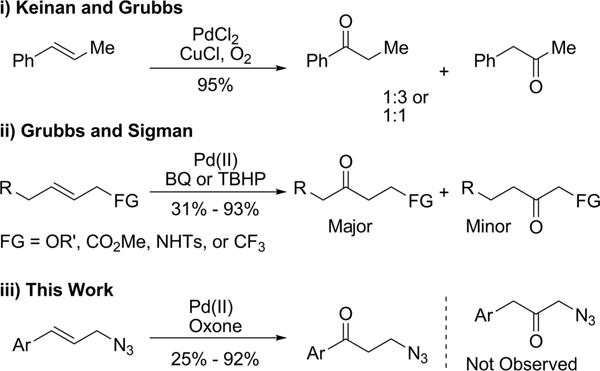
Wacker Oxidation of Internal Alkenes
In these studies, we used a number of precautions when working with azides. Azides are known to be potentially explosive. No incidents were encountered in this work. Safety shields were used for all reactions and operations, including rotary evaporation.29 No azides were synthesized that contain fewer than nine carbons, which is a common rule of thumb used for determining the stability of an azide.1,30 If working with more than 1 g of azide, we recommend that a more detailed safety analysis, such as TGA and DSC, be conducted prior to scale-up.
Initial efforts focused on identifying a highly reactive catalyst (Table 1). We were inspired by the observations of Grubbs that “ligand free” cationic palladium complexes could achieve the desired oxidation.26 Preliminarily, Pd(PhCN)2Cl2 was used as a convenient precatalyst, and a variety of silver salts were added (entries 1−5). Chloride ions exhibit strong coordination, and no Wacker oxidation was observed with the precatalyst alone (entry 1). Oxidation of the azide to the corresponding cinnamaldehyde was observed as a background reaction.4,5 However, in the presence of silver(I) salts, the desired Wacker oxidation was observed (entries 2−5). Presumably, halogen abstraction generates a more reactive cationic palladium ion in situ. The conversion and yield increased with all of the examined noncoordinating counterions. This suggests the formation of solvated Pd2+(MeCN)4 and a presumed leveling effect under the aqueous conditions. The addition of catalytic quantities of benzoquinone was advantageous (entry 5 vs 6). When benzoquinone was used as the stoichiometric oxidant, the yield was diminished (entry 7). Furthermore, control experiments revealed that silver is not necessary (entry 8) and that the nitrate ion is beneficial (entry 8 vs 9). Lastly, the procedure could be further optimized by reducing the amount of water used as a cosolvent and by adding the oxone portionwise to slow the background oxidation (entry 10 vs 11). The final procedure was conducted on the benchtop and uses readily available materials.
Table 1.
Optimization of the Wacker Oxidationa

| ||||
|---|---|---|---|---|
|
| ||||
| entry | [Pd] | AgX | additive(s) | yieldb (%) |
| 1 | Pd(PhCN)2Cl2 | 0 | ||
| 2 | Pd(PhCN)2Cl2 | AgOTf | 33 | |
| 3 | Pd(PhCN)2Cl2 | AgSbF6 | 39 | |
| 4 | Pd(PhCN)2Cl2 | AgBF4 | 18 | |
| 5 | Pd(PhCN)2Cl2 | AgNO3 | 40 | |
| 6 | Pd(PhCN)2Cl2 | AgNO3 | BQ | 73 |
| 7c | Pd(MeCN)4(BF4)2 | BQ, KNO3 | 51 | |
| 8 | Pd(MeCN)4(BF4)2 | BQ | 59 | |
| 9 | Pd(MeCN)4(BF4)2 | BQ, KNO3 | 71 | |
| 10d | Pd(PhCN)2Cl2 | AgNO3 | BQ | 67 |
| 11e | Pd(PhCN)2Cl2 | AgNO3 | BQ | 80 |
Reaction conditions: substrate (60 μmol), naphthalene standard (12 μmol), [Pd] (6 μmol, 10 mol %), AgX (15 μmol, 25 mol %), benzoquinone (12 μmol, 20 mol %), Oxone (180 μmol, 3 equiv), water (50 μL), MeCN (400 μL), under air, room temperature.
Conversion and yield were determined by calibrated GC−FID analysis. Reactions were run in duplicate, and the average value is reported.
Reaction was conducted with 1.2 equiv of benzoquinone and no Oxone.
Reaction was run using double the volume of water (100 μL).
Oxone was added portionwise.
To determine the functional group tolerance of this Wacker oxidation, the robustness screen advocated by Glorius was performed (Scheme 3).31,32 The additive approach provided the ability to rapidly assess the impact of functional groups on the reaction beyond those represented below (Scheme 4), without the need to synthesize numerous substrates. The full test set, plus a few additional additives, is shown in Scheme 3. Several of the functional groups were well tolerated, including a free alcohol (3a), nitrile (3b), ketone (3c), heterocycle (3d), alkyl halide (3e), and aryl halide (3f). Readily oxidized functional groups, such as aniline (3g), furan (3h), pyrrole (3i), and benzaldehyde (3j), were degraded. Acetal 3l hydrolyzed to benzaldehyde. Terminal alkenes (3m) underwent Wacker oxidation faster than the cinnamyl azide, and alkynes inhibited the reaction (3n and 3o). Additionally, as would be expected for an electrophilic metal center, good ligands inhibited the catalysts (3p−q). In some cases, these limitations could be overcome. For instance, 2,6-lutidine (3r) was not as strong of an inhibitor, and acetanilide (3s) was tolerated even though aniline was not.
Scheme 3.
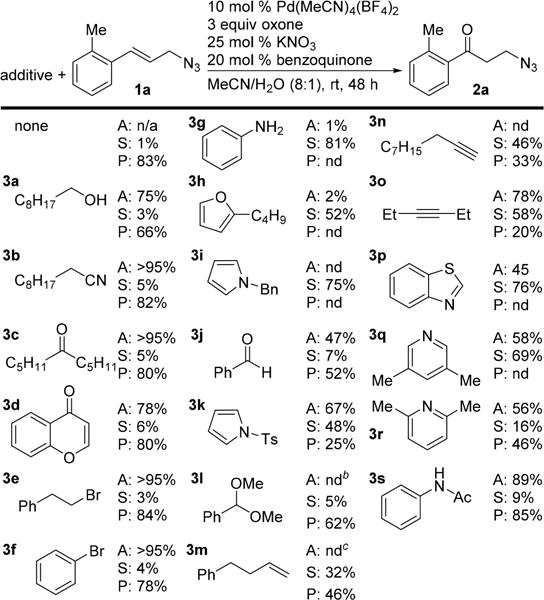
Robustness Screena
aA = additive % remaining; S = starting material % remaining; P = product % formed. Reported values determined by GC−FID analysis. A and S were determined based on a single point calibration. P was calibrated by linear regression. Values reported are the average of duplicate trials. bBenzaldehyde was observed as the major product. c4-Phenyl-2-butanone was observed as the major product.
Scheme 4.
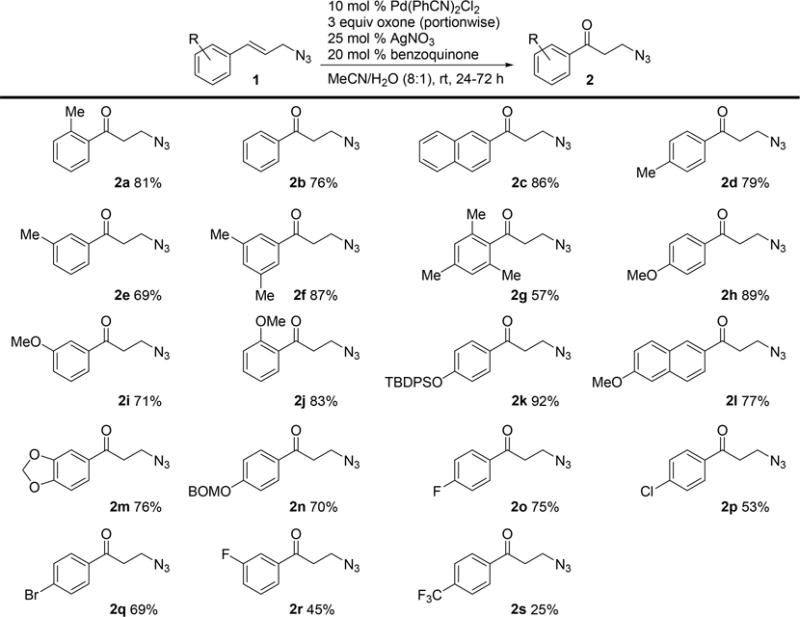
Substrate Scope of Azide-Directed Wacker Oxidationa
aYields are of isolated and purified material. Values reported are the average of duplicate trials.
A variety of substrates were examined (Scheme 4). The cinnamyl azides are directly available from commercial benzaldehydes.33 Cinnamyl azide was oxidized in comparable yield to the model substrate (2b). Other electronically neutral or methylated aryl rings provided acceptable yields (2c−f). Double ortho-substitution was tolerated, and ketone 2g was isolated in moderate yield. More electron-rich aryl rings were the preferred substrates (2h−n). Even though benzyl acetal 3l was hydrolyzed, the BOM acetal present in 2n was compatible with the reaction. Halogenated arenes showed variable compatibility with the Wacker oxidation (2o−r). A more electron deficient aryl ring provided a diminished yield (2s). We did not observe the α-azido ketone isomer in any of these reactions.
Conducting a Wacker oxidation on aliphatic azides was complicated by the Winstein rearrangement of allylic azides (Scheme 5).2,6,7 The equilibrium mixture of azides 4 and 5 was subjected to the reaction conditions. This reaction afforded an acceptable yield of ketone 6, which was contaminated with small quantities of the regioisomer 7. Azide 5 provided aldehyde 8. Aldehyde 8 is not stable under the reaction conditions, and a number of over oxidized products were observed.
Scheme 5.
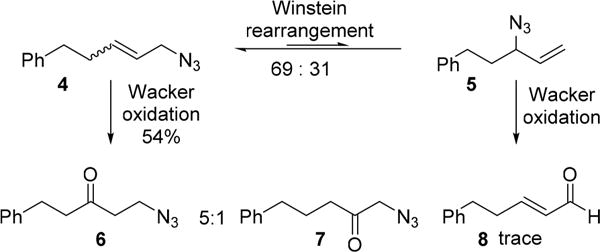
Wacker Oxidation on Equilibrating Azide
This procedure was easily conducted on a gram scale (Scheme 6). The β-azido-ketone was readily diversifiable. The ketone could be selectively reduced to provide alcohol 9. Allylation of the ketone was successful without azide elimination and afforded alcohol 10. A click reaction afforded triazole 11.
Scheme 6.
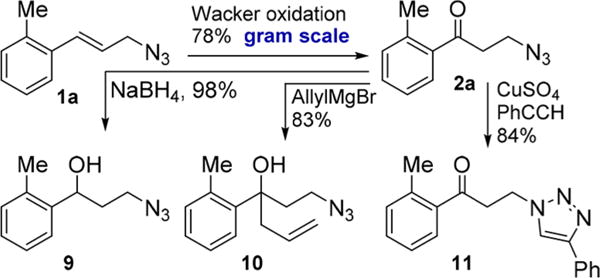
Gram-Scale Reaction and Diversification of Products
In conclusion, we developed a Wacker oxidation for cinnamyl azides that provides the aryl ketone in excellent selectivity. This procedure demonstrates the compatibility of allylic azides with palladium catalysis. The procedure is conducted under air and uses Oxone as the stoichiometric oxidant. A robustness screen was conducted, which defines the limitations of this method. Many substrates provide a high yield of the ketone product, and this procedure can be conducted on a gram scale.
Supplementary Material
Acknowledgments
Financial support was provided by the University of Minnesota and The American Chemical Society’s Petroleum Research Fund (PRF No. 56505-DNI1). This research was supported by the National Institute of General Medical Sciences of the National Institutes of Health under Award No. R35GM124718. We also acknowledge NIH Shared Instrumentation Grant No. S10OD011952.
Footnotes
Supporting Information
The Supporting Information is available free of charge on the ACS Publications website at DOI: 10.1021/acs.or-glett.8b00344.
Experimental procedures and characterization data (PDF)
ORCID
Joseph J. Topczewski: 0000-0002-9921-5102
Notes
The authors declare no competing financial interest.
References
- 1.Bräse S, Gil C, Knepper K, Zimmermann V. Angew Chem, Int Ed. 2005;44:5188. doi: 10.1002/anie.200400657. [DOI] [PubMed] [Google Scholar]
- 2.Ott AA, Goshey CS, Topczewski JJ. J Am Chem Soc. 2017;139:7737. doi: 10.1021/jacs.7b04203. [DOI] [PubMed] [Google Scholar]
- 3.Porter MR, Shaker RM, Calcanas C, Topczewski JJ. J Am Chem Soc. 2018;140:1211. doi: 10.1021/jacs.7b11299. [DOI] [PMC free article] [PubMed] [Google Scholar]
- 4.Giovani S, Singh R, Fasan R. Chem Sci. 2016;7:234. doi: 10.1039/c5sc02857d. [DOI] [PMC free article] [PubMed] [Google Scholar]
- 5.Barragan E, Bugarin A. J Org Chem. 2017;82:1499. doi: 10.1021/acs.joc.6b02705. [DOI] [PubMed] [Google Scholar]
- 6.Packard MH, Cox JH, Suding VP, Topczewski JJ. Eur J Org Chem. 2017;2017:6365. [Google Scholar]
- 7.Gagneux A, Winstein S, Young WG. J Am Chem Soc. 1960;82:5956. [Google Scholar]
- 8.Bélanger G, Dupuis M, Larouche-Gauthier R. J Org Chem. 2012;77:3215. doi: 10.1021/jo202651t. [DOI] [PubMed] [Google Scholar]
- 9.Kavala M, Mathia F, Kozisek J, Szolcsanyi P. J Nat Prod. 2011;74:803. doi: 10.1021/np100852p. [DOI] [PubMed] [Google Scholar]
- 10.Fesenko AA, Dem’Yachenko EA, Fedorova GA, Shutalev AD. Monatsh Chem. 2013;144:351. [Google Scholar]
- 11.Feldman KS, Antoline JF. Org Lett. 2012;14:934. doi: 10.1021/ol203463n. [DOI] [PMC free article] [PubMed] [Google Scholar]
- 12.Shirke RP, Ramasastry SSV. Org Lett. 2017;19:5482. doi: 10.1021/acs.orglett.7b02861. [DOI] [PubMed] [Google Scholar]
- 13.Kamal A, Malik MS, Shaik AA, Azeeza S. J Mol Catal B: Enzym. 2009;58:132. [Google Scholar]
- 14.Singh PND, Mandel SM, Sankaranarayanan J, Muthukrishnan S, Chang M, Robinson RM, Lahti PM, Ault BS, Gudmundsdóttir AD. J Am Chem Soc. 2007;129:16263. doi: 10.1021/ja077523s. [DOI] [PubMed] [Google Scholar]
- 15.Chowdhury N, Dutta S, Karthick S, Anoop A, Dasgupta S, Pradeep Singh ND. J Photochem Photobiol, B. 2012;115:25. doi: 10.1016/j.jphotobiol.2012.06.006. [DOI] [PubMed] [Google Scholar]
- 16.Sankaranarayanan J, Bort LN, Mandel SM, Chen P, Krause JA, Brooks EE, Tsang P, Gudmundsdottir AD. Org Lett. 2008;10:937. doi: 10.1021/ol703098q. [DOI] [PubMed] [Google Scholar]
- 17.Singh PND, Muthukrishnan S, Murthy RS, Klima RF, Mandel SM, Hawk M, Yarbrough N, Gudmundsdóttir AD. Tetrahedron Lett. 2003;44:9169. [Google Scholar]
- 18.Jiao J, Nguyen LX, Patterson DR, Flowers RA. Org Lett. 2007;9:1323. doi: 10.1021/ol070159h. [DOI] [PMC free article] [PubMed] [Google Scholar]
- 19.Eckert M, Fleischmann G, Jira R, Bolt H, Golka K. Ullmann’s Encycl Ind Chem. 2012;1:191. [Google Scholar]
- 20.Chaudhari DA, Fernandes RA. J Org Chem. 2016;81:2113. doi: 10.1021/acs.joc.6b00137. [DOI] [PubMed] [Google Scholar]
- 21.Cornell CN, Sigman MS. Org Lett. 2006;8:4117. doi: 10.1021/ol061662h. [DOI] [PubMed] [Google Scholar]
- 22.Wang Y-F, Gao Y-R, Mao S, Zhang Y-L, Guo D-D, Yan Z-L, Guo S-H, Wang Y-Q. Org Lett. 2014;16:1610. doi: 10.1021/ol500218p. [DOI] [PubMed] [Google Scholar]
- 23.Keinan E, Seth KK, Lamed R. J Am Chem Soc. 1986;108:3474. [Google Scholar]
- 24.Morandi B, Wickens ZK, Grubbs RH. Angew Chem, Int Ed. 2013;52:2944. doi: 10.1002/anie.201209541. [DOI] [PubMed] [Google Scholar]
- 25.Lerch MM, Morandi B, Wickens ZK, Grubbs RH. Angew Chem, Int Ed. 2014;53:8654. doi: 10.1002/anie.201404712. [DOI] [PubMed] [Google Scholar]
- 26.Morandi B, Wickens ZK, Grubbs RH. Angew Chem, Int Ed. 2013;52:9751. doi: 10.1002/anie.201303587. [DOI] [PubMed] [Google Scholar]
- 27.DeLuca RJ, Edwards JL, Steffens LD, Michel BW, Qiao X, Zhu C, Cook SP, Sigman MS. J Org Chem. 2013;78:1682. doi: 10.1021/jo302638v. [DOI] [PMC free article] [PubMed] [Google Scholar]
- 28.Liu B, Jin F, Wang T, Yuan X, Han W. Angew Chem, Int Ed. 2017;56:12712. doi: 10.1002/anie.201707006. [DOI] [PubMed] [Google Scholar]
- 29.See the Supporting Information for details.
- 30.Bräse S, Banert K. Organic Azides: Synthesis and Applications. John Wiley & Sons, Ltd.; 2010. [Google Scholar]
- 31.Collins KD, Glorius F. Nat Chem. 2013;5:597. doi: 10.1038/nchem.1669. [DOI] [PubMed] [Google Scholar]
- 32.Gensch T, Teders M, Glorius F. J Org Chem. 2017;82:9154. doi: 10.1021/acs.joc.7b01139. [DOI] [PubMed] [Google Scholar]
- 33.Goswami PP, Suding VP, Carlson AS, Topczewski JJ. Eur J Org Chem. 2016;2016:4805. [Google Scholar]
Associated Data
This section collects any data citations, data availability statements, or supplementary materials included in this article.


